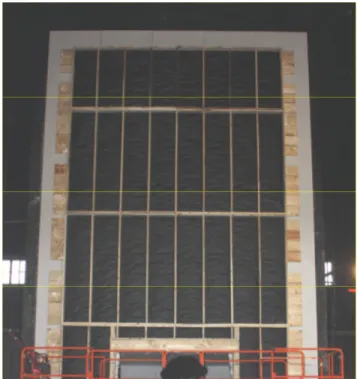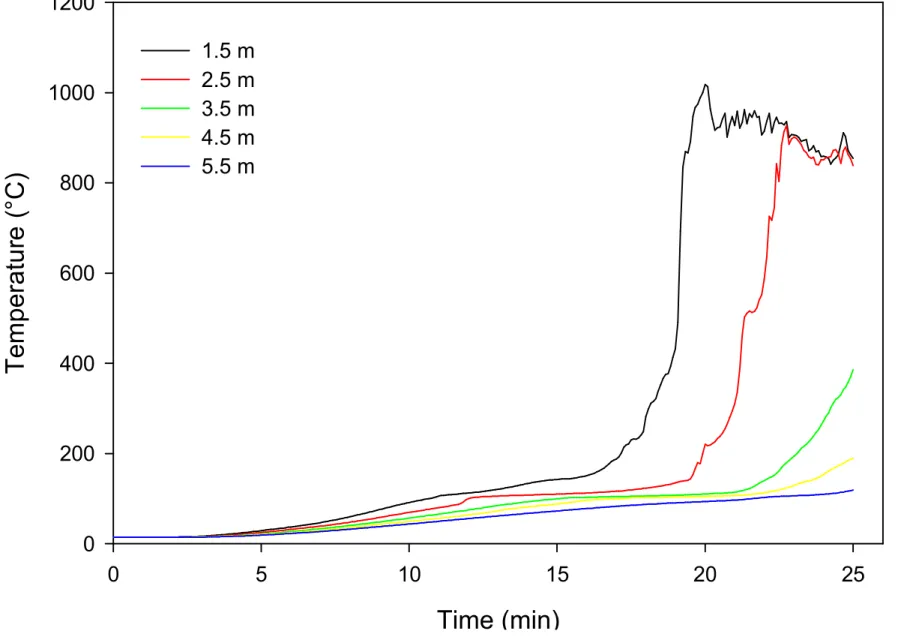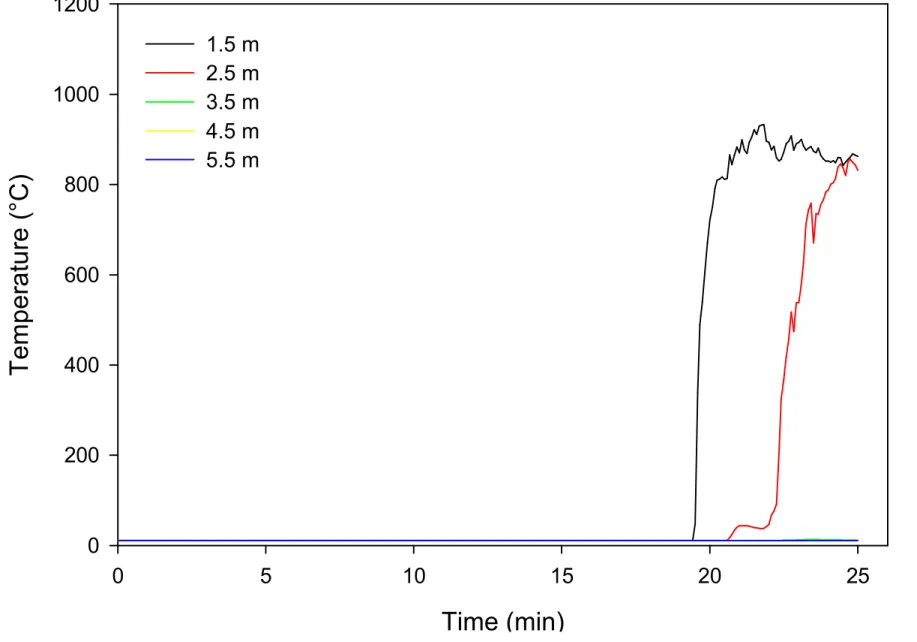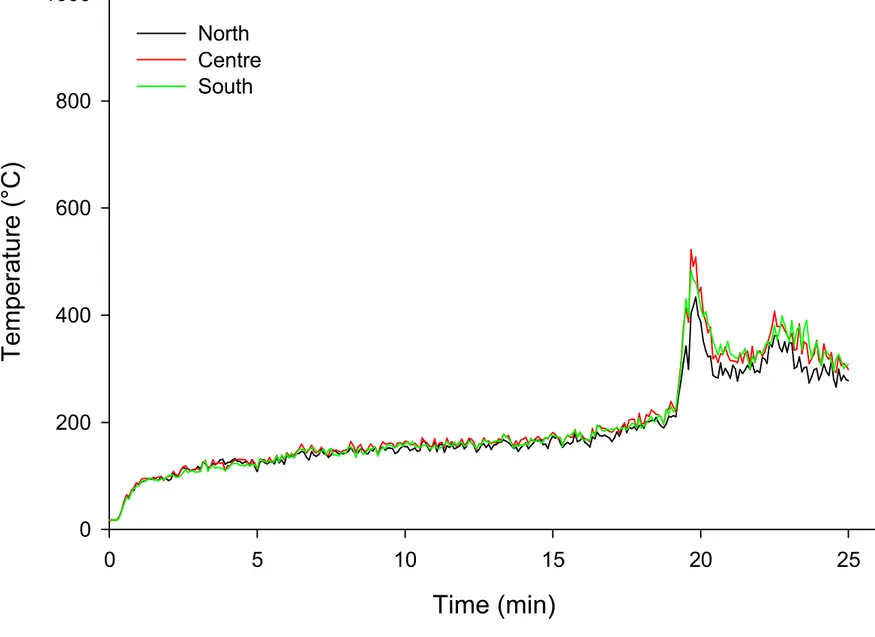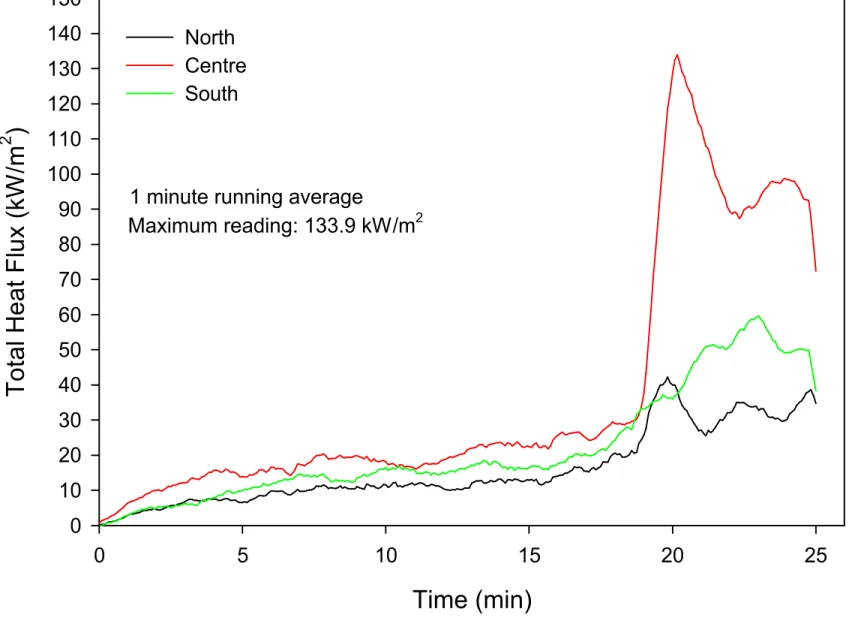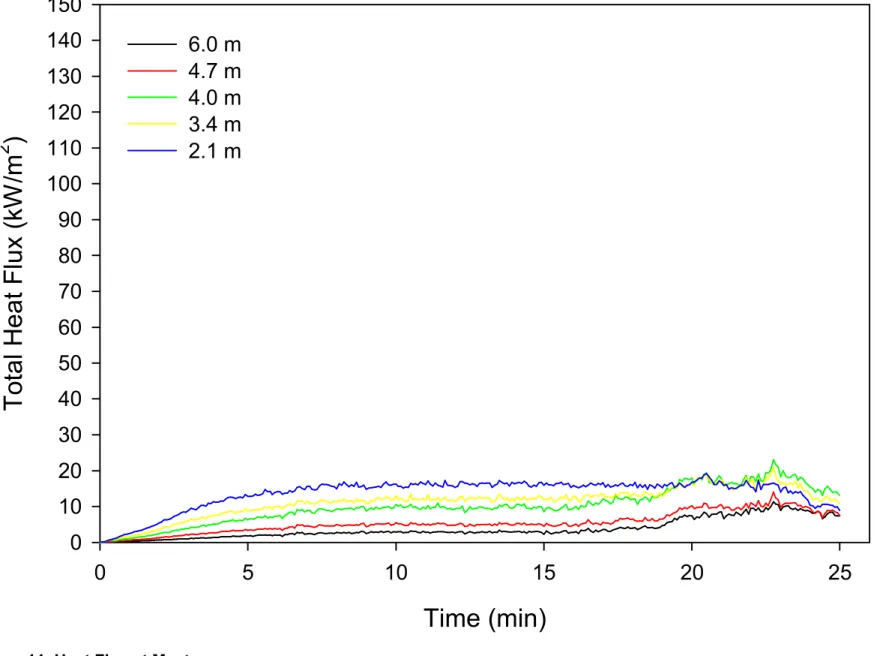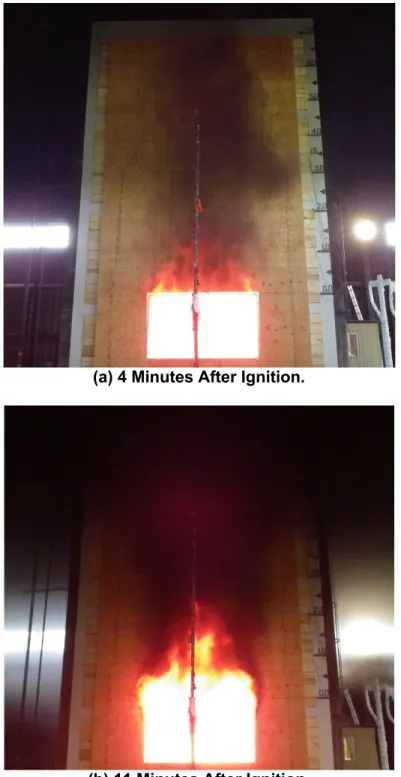Publisher’s version / Version de l'éditeur:
Vous avez des questions? Nous pouvons vous aider. Pour communiquer directement avec un auteur, consultez la Questions? Contact the NRC Publications Archive team at
PublicationsArchive-ArchivesPublications@nrc-cnrc.gc.ca. If you wish to email the authors directly, please see the first page of the publication for their contact information.
https://publications-cnrc.canada.ca/fra/droits
L’accès à ce site Web et l’utilisation de son contenu sont assujettis aux conditions présentées dans le site LISEZ CES CONDITIONS ATTENTIVEMENT AVANT D’UTILISER CE SITE WEB.
Client Report (National Research Council of Canada. Construction), 2014-12-31
READ THESE TERMS AND CONDITIONS CAREFULLY BEFORE USING THIS WEBSITE.
https://nrc-publications.canada.ca/eng/copyright
NRC Publications Archive Record / Notice des Archives des publications du CNRC : https://nrc-publications.canada.ca/eng/view/object/?id=e49f57e1-5a0c-4eba-955c-d82eb6281cd3 https://publications-cnrc.canada.ca/fra/voir/objet/?id=e49f57e1-5a0c-4eba-955c-d82eb6281cd3
NRC Publications Archive
Archives des publications du CNRC
For the publisher’s version, please access the DOI link below./ Pour consulter la version de l’éditeur, utilisez le lien DOI ci-dessous.
https://doi.org/10.4224/21274561
Access and use of this website and the material on it are subject to the Terms and Conditions set forth at
Solutions for mid-rise wood construction: full-scale standard fire test
for exterior wall assembly using a simulated cross-laminated timber
wall assembly with interior fire-retardant-treated plywood sheathing:
Test EXTW-4: report to Research Consortium for Wood and
Wood-Hybrid Mid-Rise Buildings
NATIONAL RESEARCH COUNCIL CANADA
REPORT TO RESEARCH CONSORTIUM
FOR WOOD AND WOOD-HYBRID
MID-RISE BUILDINGS
Solutions for Mid-Rise Wood Construction
:
Full-scale Standard Fire Test for Exterior
Wall Assembly using a Simulated
Cross-Laminated Timber Wall Assembly with
Interior Fire-Retardant-Treated Plywood
Sheathing (Test EXTW-4)
CLIENT REPORT: A1-100035-01.7
December 31, 2014
REPORT TO RESEARCH CONSORTIUM FOR WOOD AND
WOOD-HYBRID MID-RISE BUILDINGS
Solutions for Mid-Rise Wood Construction:
Full-scale Standard Fire Test for Exterior Wall Assembly using a
Simulated Cross-Laminated Timber Wall Assembly with Interior
Fire-Retardant-Treated Plywood Sheathing Test EXTW-4
E. Gibbs, B.C. Taber, G.D. Lougheed, J.Z. Su and N. BénichouReport No. A1-100035-01.7 Report date: December 31, 2014 Contract No. B-7000 (A1-100035) Prepared for Canadian Wood Council
FPInnovations
Régie du bâtiment du Québec
HER MAJESTY THE QUEEN IN RIGHT OF ONTARIO as represented by the Minister of Municipal Affairs and Housing
23 pages
This report may not be reproduced in whole or in part without the written consent of both the client and the National Research Council of Canada.
TABLE OF CONTENTS
Contents
1 Introduction ...1
2 Test Facility...3
3 Description of Test Wall Assembly ...5
4 Instrumentation ...8
5 Atmospheric Conditions ...9
6 Test Procedure...9
7 Visual Observations ...9
8 Results...10
9 Performance of the Wall Assembly...20
10 Remarks...22
11 Acknowledgments ...22
12 References ...23
LIST OF FIGURES Figure 1. Test Facility (front view)...4
Figure 2. Test Facility (side view). ...4
Figure 3. Construction Detail. ...7
Figure 4. Wall System Under Construction...8
Figure 5. Average Room and Window OpeningTemperatures...13
Figure 6. Temperatures on Surface of Wall. ...14
Figure 7. Temperatures Behind the Sheathing. ...15
Figure 8. Temperatures on Surface of WRB...16
Figure 9. Temperatures at Top of Wall. ...17
Figure 10. Heat Flux on Wall. ...18
Figure 11. Heat Flux at Mast. ...19
Figure 12. Wall Sample During the Fire Exposure...21
Figure 13. Wall Sample after Fire Exposure. ...22
LIST OF TABLES Table 1. Average Values of Heat Flux at Target Mast. ...20
SOLUTIONS FOR MID-RISE WOOD CONSTRUCTION:
FULL-SCALE STANDARD FIRE TEST FOR EXTERIOR WALL ASSEMBLY USING A SIMULATED CROSS-LAMINATED TIMBER WALL ASSEMBLY WITH INTERIOR
FIRE-RETARDANT-TREATED PLYWOOD SHEATHING
E. Gibbs, B.C. Taber, G.D. Lougheed, J.Z. Su and N. Bénichou
1 INTRODUCTION
The acceptable solutions provided in the 2010 National Building Code (NBC) Division B [1] limits the use of combustible (wood) construction based on building height. For example, for Group C (Residential), Group D (Business and Personal Services) and Group E (Mercantile) occupancies, combustible construction can be used up to 4 storeys, and up to 2 storeys for Group A – Division 2 (Assembly) occupancies. In addition to the building height limitation, there are also building area limitations in the 2010 NBC for the use of combustible construction for these occupancies. For buildings that exceed the height and area requirements for combustible construction, the
prescriptive requirements in the 2010 NBC require that noncombustible construction be used for the primary structural elements.
The prescriptive construction requirements for fire safety and protection of buildings, which are dependent upon the building size and occupancy type, are provided in Subsection 3.2.2 of the 2010 NBC. This includes the identification of the buildings for which noncombustible construction is required. The intent of the prescriptive
requirements for noncombustible construction as they relate to the NBC fire safety/fire protection of building objectives is “to limit the probability that combustible construction
materials within a storey of a building will be involved in a fire, which could lead to the growth of fire, which could lead to the spread of fire within the storey during the time required to achieve occupant safety and for emergency responders to perform their duties, which could lead to harm to persons/damage to the building”.
The 2010 NBC defines noncombustible construction as “that type of construction in
which a degree of fire safety is attained by use of noncombustible construction materials for structural members and other building assemblies” [1]. Article 3.1.5.1 requires that a
building or part of a building required to be of noncombustible construction be
constructed using noncombustible materials. The intent of this requirement, as it relates to the NBC fire safety/fire protection of building objectives, is “to limit the probability that
construction materials will contribute to the growth and spread of fire, which would lead to harm to persons/damage to the building”.
The NBC does permit, as exceptions, an extensive use of combustible materials in buildings otherwise required to have their primary structural elements to be of noncombustible construction. The allowed materials and associated limitations are primarily provided in Articles 3.1.5.2 to 3.1.5.21. Generally, the combustible elements permitted relate to interior finishes, gypsum board, combustible roofing materials, combustible plumbing fixtures, cabling, protected insulation, flooring, combustible glazing, combustible cladding systems, non-loadbearing framing elements in partitions, stairs in dwellings, and trim and millwork, among others.
Divisions B of the NBC (the “acceptable solutions” portion of the Code) generally does not permit combustible materials to be used for the primary structural elements in buildings required to be of noncombustible construction. In the Scoping Study [2] for mid-rise and hybrid buildings, it was suggested that an alternative solution using wood construction may be developed to meet the intent of the prescriptive “noncombustibility” requirement for mid-rise (and taller) buildings. As one approach, encapsulation materials could be used to protect the combustible (wood) structural materials for a period of time in order to delay the effects of the fire on the combustible structural elements, including delay of ignition. In delaying ignition, any effects of the combustion of the combustible structural elements on the fire severity can be delayed. In some cases, and depending upon the amount of encapsulating material used (e.g. number of layers), ignition of the elements might be avoided completely. This scenario would primarily depend upon the fire event and the actual fire performance of the encapsulating materials used. A
research project, Wood and Wood-Hybrid Midrise Buildings, was undertaken to develop information to be used as the basis for alternative/acceptable solutions for mid-rise construction using wood structural elements.
In Article 3.1.5.5, the NBC allows the use of combustible components for non-loadbearing exterior walls to be used in a building required to be of noncombustible construction provided:
a) the building is
i. not more than 3 storeys in height, or ii. sprinklered throughout,
b) the interior surfaces of the wall assembly are protected by a thermal barrier conforming to Sentence 3.1.5.12.(3), and
c) the wall assembly satisfies the criteria of Sentence 3.1.5.5.(3) and 3.1.5.5.(4) when subjected to testing in conformance with CAN/ULC-S134 Fire Test of
Exterior Wall Assemblies [3].
Since the introduction of the requirements for the use of combustible components for non-loadbearing exterior walls in noncombustible construction, a number of proprietary cladding systems have been developed that meet the requirements in the NBC when tested using CAN/ULC-S134. However, one assumption in this testing is that the non-loadbearing exterior wall assemblies will be used in conjunction with an exterior wall system constructed using noncombustible structural elements either as infill or panel type walls between structural elements or attached directly to a loadbearing
noncombustible structural system (see Appendix Note A-3.1.5.5.(1) of the 2010 NBC). During the development of the CAN/ULC-S134 test method, three assemblies using lightweight wood frame construction met the criteria in the 2010 NBC for
non-loadbearing exterior walls [4, 5]:
1. Assembly 3.1. - Vinyl siding on gypsum sheathing on glass-fibre-insulated untreated (non-fire-retardant-treated) wood frame wall;
2. Assembly 3.3. - 12.7 mm fire-retardant-treated plywood on untreated (non-fire-retardant-treated) wood studs, with phenolic foam insulation in cavities; and 3. Assembly 3.4. - Aluminum sheet (0.75 mm) on fire-retardant-treated wood studs,
The results of the original three tests can currently provide the basis for developing generic alternative solutions for exterior wall assemblies for use in mid-rise buildings using lightweight wood frame construction. However, generic alternative solutions based on these tests would be limited by the materials tested, including the insulation types used in the original tests.
One of the tasks in the project, Wood and Wood-Hybrid Midrise Buildings, was to develop further information and data for use in developing generic exterior wall systems for use in mid-rise buildings using either lightweight wood frame or cross-laminated timber as the structural elements. This report describes a standard full-scale exterior wall fire test conducted on October 30, 2012 on a simulated cross-laminated timber (CLT) wall assembly with an attached insulated lightweight wood frame assembly protected using interior fire-retardant-treated (FRT) plywood sheathing. The test was conducted in accordance with CAN/ULC-S134 [3].
2 TEST FACILITY
The test was conducted using the exterior wall fire test apparatus as described in CAN/ULC-S134 (see Figure 1 and Figure 2) located in the Burn Hall of the NRC Fire Laboratory, Almonte, Ontario.
The burn room portion of the apparatus consisted of a reinforced concrete floor, concrete block walls and a precast concrete panel ceiling. The walls and ceiling were covered on the room side with 25 mm thick ceramic fibre insulation. The floor was covered with 57 mm thick fired clay paving stones. The inside dimensions of the burn room were 5.95 m wide, 4.4 m deep and 2.75 m high.
The fuel source in the burn room consisted of four 3.8 m long linear propane burners spaced equally along the width of the room and designed to provide a fire exposure equivalent to uniformly-distributed wood cribs of kiln-dried pine (with pieces 38 mm x 89 mm), having a total mass of approximately 675 kg. The burners were mounted 0.6 m above the surface of the paving stones.
Legend Thermocouple
Heat flux meter All dimensions in mm
Figure 1. Test Facility (front view).
Figure 2. Test Facility (side view).
4400 2750 3000 1300 2400 1300 1300 Mast Wall Sample 2100
N
3 DESCRIPTION OF TEST WALL ASSEMBLY
The wall assembly simulated an exterior CLT wall with attached non-loadbearing insulated lightweight wood framing protected using 15.9 mm thick fire-retardant-treated plywood. The wall assembly was installed over 15.9 mm thick Type X gypsum board that formed part of the test facility. Drawings for the wall assembly are shown in Figure 3 and a photograph for the wall assembly under construction is shown in Figure 4.
The CLT portion of the wall assembly was simulated using 38 mm x 235 mm lumber laid flat and attached horizontally to the test facility with its wider side against the test
facility’s concrete block wall. The wall of the test facility was covered with the lumber to a width of approximately 5 m and a height of 9.9 m.
CLT wall systems can be much thicker than the simulated system used. However, a thickness of 38 mm was considered adequate for this testing because if, during the test, there was sufficient burning of the lumber to char through the 38 mm thickness provided, it is very likely that the wall system would not meet the requirements in 3.1.5.5. of the 2010 NBC anyway, and therefore any additional thickness of wood would be redundant. A water resistant barrier (WRB) was attached to the simulated CLT wall. This material was paper impregnated with asphalt. This type of WRB (identified as WRB-1 in
Reference [6]) was selected for use in the full-scale exterior wall assembly tests based on the results of cone calorimeter tests, which indicated that it ignited earlier and had a higher peak heat release rate and total heat output than a thermoplastic polyolefin (TPO) WRB.
An insulated wall sections were attached to the simulated CLT wall. Wall sections were constructed using 2 x 6 studs spaced at 600 mm on center (o.c.). The studs were 38 mm x 140 mm x 2400 mm long. The wall sections included a single base plate and a single top plate constructed using 38 mm x 140 mm x 2400 mm lumber.
Interior FRT plywood sheathing (15.9 mm x 1.2 m x 2.4 m panels with standard edges) was used as the exterior surface of the wall assembly. The FRT plywood sheathing complied with CAN/CSA-O80 Series-08 [7]. The material was combustible, had a surface flame-spread rating of 25, and a smoke developed classification of 25. The FRT plywood sheathing was attached using 50 mm long common nails at 200 mm spacing. The cavity spaces formed by the wood studs were filled to the 140 mm depth using extruded polystyrene (XPS) foam insulation panels. Two panels with a thickness of approximately 50 mm and one with a thickness of approximately 39 mm were used to provide the required thickness. The sides of the panels were trimmed to provide the width needed to fit into the cavity space.
The XPS foam insulation used in the test assembly was selected based on cone
calorimeter tests that showed that XPS rigid foam insulation had higher heat output than expanded polystyrene (EPS) rigid foam insulation [6]. Of the three XPS rigid foam insulation products tested, the product identified as G-XPS in Reference 6 had the highest heat output and was used in the full-scale test.
Although an XPS foam insulation was used in the test assembly, it was assumed that, if the assembly using an XPS foam insulation met the requirements in 3.1.5.5. of the 2010 NBC for exterior wall systems, exterior wall assemblies insulated using EPS rigid foam insulation panels or non-combustible mineral fibre insulation would also meet the requirements.
The bottom wall section included an opening that was the same size as the window opening in the test facility. Standard framing for windows was used with double studs used on either side of the window opening and a double header using 38 mm x 235 mm lumber was installed above the window opening (Figure 3).
Metal flashing (approximately 25 mm by 25 mm) was located at the outer edge of the window opening. The flashing was fastened to the assembly inside the window opening. The edges of the wall assembly at the window opening and the metal flashing were covered with 25 mm thick ceramic fibre insulation. The metal flashing and ceramic fibre insulation are typically used for CAN/ULC-S134 test assemblies to limit flame
penetration at the edges of the test wall assembly.
The full test specimen was 9.9 m high and approximately 5.0 m wide, with a window opening 2.5 m wide and 1.45 m high. The wall assembly extended 7 m above the window opening in the test facility. It conformed to the height and width requirements for CAN/ULC-S134 [3].
A horizontal joint between FRT plywood sheathing panels was located 3.0 m above the window opening. This complies with the requirement in CAN/ULC-S134 [2] that a horizontal joint is located 2.7 ± 0.3 m above the window opening in the wall assembly. Additional horizontal joints were located at the 0.6 m and 5.4 m heights.
The test assembly had a vertical joint above the window opening on the centerline of the assembly. It also had vertical joints 1.2 m to either side of the centerline of the assembly. The test assembly simulated a structural exterior wall system. However, no loads were applied to the wall. The objective of the test was to evaluate the performance of the assembly for exterior fire spread. If, in practice, the exterior wall assembly required a fire-resistance rating as well, it would need to be evaluated using CAN/ULC-S101 [8]. The construction materials of the test wall assembly proceeding outward from the concrete block wall of the test facility were as follows:
1. 15.9 mm thick Type X gypsum board;
2. CLT wall simulated using 38 mm x 235 mm lumber laid flat and installed horizontally on the test facility;
3. Lightweight wood framing and XPS foam insulation; and, 4. 15.9 mm thick interior FRT plywood sheathing.
An exterior cladding system was not included in the test assembly. It was assumed that a noncombustible exterior cladding would provide additional protection for the wall assembly and, therefore, if the wall assembly met the requirements in Article 3.1.5.5. of the 2010 NBC without an exterior cladding, it would also meet the requirements with a noncombustible cladding.
Wall Installation # 2 Figure 3. Construction Detail.
Top of wall 7 m above window opening
Horizontal joint 3 m above window opening
Studs at 600 mm o.c.OC Single base plate Single top plate
Double 38 x 235 mm header Simulated CLT 38 mm x 235 mm lumber Ceramic fibre insulation 3000 mm 7000 mm
Figure 4. Wall System Under Construction. 4 INSTRUMENTATION
Room Temperatures – The burn room air temperature was monitored by six Type K thermocouples, enclosed in 6 mm (outside diameter) Inconel sheaths. The
thermocouples were introduced through the side walls with the measuring tips 0.6 m from the inner surface of the wall. All room thermocouples were located on the vertical centre lines of the side walls.
Window Opening Temperatures – The temperature of the flames issuing from the window was measured with three Type K, bare-beaded thermocouples installed 0.15 m below the top of the window opening, on the vertical centre line of the window opening and 0.4 m from the sides of the window opening (see Figure 1).
Wall Temperatures – The wall temperatures were monitored using Type K bare-beaded thermocouples on the vertical centre line of the wall. They were located at five levels above the top of the window opening at 1.0 m intervals, starting at 1.5 m above the window opening (see Figure 1). Three thermocouples were used at each level, one on the exterior surface of the wall assembly, the second behind the FRT plywood sheathing (between the FRT plywood sheathing and the XPS foam insulation) and the third on the surface of the WRB (between the WRB and the XPS foam insulation).
The temperature of the fire plume at the top of the test assembly was monitored by three Type K bare-beaded thermocouples located 0.1 m out from the exterior surface of the wall, one on the centre line of the wall, and the other two at a distance of 1.3 m from both the edges of the wall (see Figure 1).
Heat Flow – The total heat flux to the wall above the window opening was monitored by three water-cooled heat flux meters (Medtherm Corp. Series 64) installed in the test wall, 3.5 m above the top of the window opening, one on the centre line of the wall and one on each side, 0.5 m from the centre line (see Figure 1).
Radiant heat emitting from the fire was also monitored by heat flux meters (Medtherm Corp. Series 64) installed on a mast (Figure 2), placed 3.0 m from the test wall opposite to the centre line of the wall. The heat flux meters were located at distances of 2.1 m, 3.4 m, 4.7 m and 6.0 m above the level of the burn room floor. An additional heat flux meterr was installed on the mast at the 4.0 m height and 2.4 m from the face of the wall.
Propane – The propane gas flow rate to the burners was monitored with a mass flow meter.
Visual Records – Video records of the front and side views were made during the test and digital photos were taken before, during and after the test.
Data Acquisition – All thermocouples, as well as the heat flux meters, were connected to a data acquisition system and readings were recorded at 5 s intervals.
5 ATMOSPHERIC CONDITIONS
At the time of the test, the ambient temperature in the Burn Hall was 5.0°C and the relative humidity was 94%.
6 TEST PROCEDURE
The test procedure was in accordance with CAN/ULC-S134-13 [3]. The pilot burners were lit prior to the commencement of the test. Gas flow to the burners was manually adjusted to follow the prescribed heat input required by the standard.
7 VISUAL OBSERVATIONS
(min:sec)
0:00 Ignition of burners
1:57 Flames are exiting the room 2:25 Flames are reaching 0.5 to 1.0 m 3:27 Flames are reaching 1.5 m
3:55 FRT plywood began to char behind window opening fire plume 4:33 Flames are reaching 1.5 to 2.0 m
5:00 Steady state gas flow
5:24 Fire is present on the sample below 1.5 m
6:23 Crackling is heard, small flames to 3.0 m then quickly back to 2.0 m 7:33 Small flames behind window opening fire plume below 1.5 m
9:30 Fire plume is reaching 2.5 m 12:56 Embers are falling to the floor
16:29 More crackling is heard
16:40 A piece of the sample falls to the floor 17:00 More debris falling
17:28 Exposed area is approximately 0.6 x 0.6 m 17:46 Flames are reaching 4 m in height
18:30 Flames are reaching 5 m, fire is intense and attached to the wall 19:49 Fire is surpassing 5 m and growing in size
20:00 Gas reduction begins 20:46 Fire is still over 5 m
21:36 The flame is approximately 1.0 m wide and reaches the top of the wall 22:00 FRT plywood sheathing below 3 meters has burned away
25:00 Data Off (fire extinguished to avoid damage to facility)
8 RESULTS
Room Temperatures – The average gas temperature in the burn room (average of six thermocouples) was as shown in Figure 5.
Window Opening Temperatures – The average temperature of the fire gases emerging from the window opening was as shown in Figure 5.
Wall Temperatures – The temperatures recorded on the outer surface of the test assembly are shown in Figure 6. The temperatures reached a peak of 1005°C at 1.5 m above the window opening, 920°C at 2.5 m above the window opening, 878°C at 3.5 m above the window opening, 840°C at 4.5 m above the window opening and 709°C at 5.5 m above the window opening. The peak temperatures occurred at approximately 20 min at all heights.
The temperatures recorded by the thermocouples within the assembly between the FRT plywood sheathing and the XPS foam insulation are shown in Figure 7. The
temperatures reached a peak of 1019°C at 1.5 m above the window opening, 927°C at 2.5 m above the window opening, 386°C at 3.5 m above the window opening, 188°C at 4.5 m above the window opening and 119°C at 5.5 m above the window opening. There was a rapid increase in the temperature measured between the FRT plywood sheathing and the XPS foam insulation at the 1.5 m height after 15 min. At 20 min, the temperature inside the test assembly was comparable to the temperature measured on the outside of the assembly, indicating that the FRT plywood sheathing had fallen off up to this height.
Similarly, there was a rapid increase in temperature between the FRT plywood
sheathing and the XPS foam insulation beginning at approximately 20 min at the 2.5 m height. By approximately 23 min, the temperature measured by the thermocouple inside the assembly was comparable to that measured on the exterior, indicating the FRT plywood sheathing had fallen off up to the 2.5 m height.
Temperatures recorded by the thermocouples behind the XPS foam insulation, on the surface of the WRB, are shown in Figure 8. Only the thermocouples at the 1.5 m and 2.5 m heights indicated a rise in temperature. The test ended before the fire could progress to the other thermocouple locations.
Once the FRT plywood fell off, the insulation was burned by the fire, producing the initial peak heat output in the cavity at approximately 20 min at the 1.5 m height and at
approximately 23 min at the 2.5 m height (Figure 7). With the burn through of the foam insulation, there was a rapid increase in temperatures to greater than 800C measured on the WRB. These temperatures were sustained until the end of the test, suggesting the WRB and subsequently the simulated CLT were ignited and continued to burn. The fire plume temperatures measured at the top of the wall are shown in Figure 9. The temperatures at the top of the wall reached a maximum of 522°C at approximately 20 min. The initial peak temperature was most likely due to the burning of the XPS foam insulation. The initial peak was followed by sustained temperatures of 300 – 400C until the end of the test.
Heat Flux – The total heat flux to the wall, as measured 3.5 m above the top of the window opening, is shown in Figure 10. The data shown in this figure has been smoothed using the procedure of a running average over one minute.
The heat flux values at all three locations showed a steady rise in exposure over the first 5 minutes. Between 5 and 15 min, there were fluctuations in the measured heat flux values but they were typically < 25 kW/m2on the centerline of the test assembly and
< 20 kW/m2at the north and south heat flux meters. After 15 min, there was an initial
steady increase in the heat flux values measured by the three devices followed by a rapid increase beginning at approximately 17 min. The maximum one-minute averaged values recorded at the 3 locations were 133.9 kW/m2at the centre location, 42.2 kW/m2
at the north location and 59.27 kW/m2at the south location. The peak heat flux values
measured by the devices at the centre and north locations were at approximately 20 min and most likely corresponded to the burning of the foam insulation. The peak exposure at the south device occurred at approximately 23 min.
After the peak heat flux, there was a reduction in the measured heat flux. However, high heat flux values were measured by the three devices until the end of the test.
The heat flux values measured by the heat flux meters installed on the mast are shown in Figure 11. The heat flux at the 2.1 m height reached 19.1 kW/m2, at the 3.4 m height it
reached 20.9 kW/m2, at the 4.7 m height it reached 14.0 kW/m2and at the 6.0 m height it
reached 11.3 kW/m2. The heat flux at 2.4 m from the wall at the 4.0 m level reached 23.1
kW/m2.
There was an initial increase in the heat flux values measured by all the devices as the fire inside the fire compartment developed during the initial 5 min. Subsequently, the heat flux values at each location remained steady until approximately 15 min, after which there was an increase in the measured heat flux values to an initial peak at
approximately 20 min. However, for all devices except the one located at the 2.1 m height, the highest exposure levels were at approximately 23 min. and were the result of the fire burning upwards on the wall.
The heat flux values at the 3.4 m height and 3 m from the wall assembly and at the 4.0 m height and 2.4 m from the wall assembly exceeded 20 kW/m2. At these heat flux
values, autoignition can occur for combustible materials if the exposure is sustained for a sufficient time.
Time (min)
0
5
10
15
20
25
T
e
m
p
er
a
tu
re
(
°C
)
0
200
400
600
800
1000
1200
1400
Room Average
Time (min)
0
5
10
15
20
25
T
e
m
pe
ra
tu
re
(
°C
)
0
200
400
600
800
1000
1200
1.5 m
2.5 m
3.5 m
4.5 m
5.5 m
Time (min)
0
5
10
15
20
25
T
em
pe
ra
tu
re
(
°C
)
0
200
400
600
800
1000
1200
1.5 m
2.5 m
3.5 m
4.5 m
5.5 m
Time (min)
0
5
10
15
20
25
T
em
pe
ra
tu
re
(
°C
)
0
200
400
600
800
1000
1200
1.5 m
2.5 m
3.5 m
4.5 m
5.5 m
Time (min)
0
5
10
15
20
25
T
e
m
p
er
at
u
re
(
°C
)
0
200
400
600
800
1000
North
Centre
South
Time (min)
0
5
10
15
20
25
T
o
ta
l H
e
a
t
F
lu
x
(k
W
/m
2)
0
10
20
30
40
50
60
70
80
90
100
110
120
130
140
150
North
Centre
South
1 minute running average
Maximum reading: 133.9 kW/m
2Contract # B-7000
Time (min)
0
5
10
15
20
25
T
ot
a
l H
e
a
t
F
lu
x
(k
W
/m
2)
0
10
20
30
40
50
60
70
80
90
100
110
120
130
140
150
6.0 m
4.7 m
4.0 m
3.4 m
2.1 m
9 PERFORMANCE OF THE WALL ASSEMBLY
A) Flame Spread over Exterior Face
There were minimal events in the first 16 minutes of the test. At this time, a small piece of FRT plywood fell off the face of the sample. This gave the fire access to the inside cavity and the insulation. The fire began to grow at a fast pace and kept up its fast growth well after gas reduction had begun. The flames reached the top of the test wall and were suppressed at 25 minutes to avoid damage to the facility.
B) Incremental Radiant Heat Flow to the Wall above the Window Opening
The maximum one-minute averaged value of the total heat flux on the test wall at 3.5 m above the top of the window opening was 133.9 kW/m2This is more than the 35 kW/m2
specified in Sentence 3.1.5.5.(4) of the 2010 NBC [1]. ]. For comparison, the value for a noncombustible wall (Marinite) is 16 kW/m2. (Note: Marinite is a thermal structural board
insulation, which is a formed from calcium silicate with inert fillers and reinforcing agents. This material was used to provide the noncombustible wall, which was used for
calibration and reference purposes in the initial test series used to develop the test method [5]).
C) Incremental Radiant Heat Flow at Target Mast
The average values of heat flux at the target mast over the 15 min period of steady gas supply, as compared to noncombustible wall (Marinite), were:
Table 1. Average Values of Heat Flux at Target Mast.
Distance from Test Assembly (m) Height Above Burn Room Floor (m) Heat Flux (kW/m2) Lightweight Wood Frame Wall Assembly Noncombustible Wall Assembly (Marinite) 3.0 2.1 15.7 15.9 3.0 3.4 12.2 11.2 2.4 4.0 10.2 8.2 3.0 4.7 5.2 4.7 3.0 6.0 3.1 2.1
These averages do not reflect the elevated exposures that happened after 20 minutes. D) Damage to the Wall Assembly
Figure 12 shows the wall assembly at two different times during the fire exposure. Figure 13 shows the extent of the damage to the wall sample after the test.
(a) 4 Minutes After Ignition.
(b) 11 Minutes After Ignition. Figure 12. Wall Sample During the Fire Exposure.
Figure 13. Wall Sample after Fire Exposure. 10 REMARKS
1. The test facility and test method, as described in this report, conform to the
requirements of Article 3.1.5.5 of the 2010 edition of the National Building Code of Canada. The test was conducted in accordance with CAN/ULC-S134 [3].
2. During the fire exposure there were flames to 5.5 m above the window opening. This is more than the 5 m limit for flame spread distance specified in
Sentence 3.1.5.5.(3) and defined in Appendix A (A-3.1.5.5.(3)) of the 2010 NBC [1].
3. The maximum one-minute averaged value of the total heat flux on the test wall assembly, at 3.5 m above the top of the window opening during the fire exposure, was 133.9 kW/m2. This is more than the 35 kW/m2specified in Sentence
3.1.5.5.(4) of the 2010 NBC [1].
4. The fire was suppressed at 25 minutes to avoid damage to the facility. 5. There was damage to the CLT up to 3.0 meters.
6. Most of the elevated values for heat-flux happened after the gas reduction began at 20 minutes.
11 ACKNOWLEDGMENTS
Financial and in-kind support for the project provided by the following organizations is gratefully acknowledged:
Canadian Wood Council
Forestry Innovation Investment BC FPInnovations
Ontario Ministry of Municipal Affairs and Housing National Research Council Canada
Natural Resources Canada Régie du Bâtiment du Québec
Quebec government (Société d’Habitation du Québec, Société Immobilière du Québec, Ministère des Ressources Naturelles)Extensive technical input by staff from collaborating organizations is also gratefully acknowledged:
Rodney McPhee and Ineke Van Zeeland, Canadian Wood Council. Christian Dagenais, Mohammad Mohammad and Lindsay Osborne,
FPInnovations.
12 REFERENCES
1. 2010 NBC, National Building Code of Canada, National Research Council, Ottawa, Ontario, 2010.
2. Su, J., Gover, B., Lougheed, G., Benichou, N., Swinton, M., Schoenwald, S.,
Lacasse, M., Di Lenardo, B., Mostafaei, H. and Pernica, G., Wood And Wood-Hybrid Mid-Rise Buildings, Phase 1: Scoping Study, B4726.1, National Research Council, Ottawa, Ontario, 2011.
3. CAN/ULC-S134, Fire Test of Exterior Wall Assemblies, Underwriters Laboratories of Canada, Ottawa, Ontario, 2013.
4. Chauhan, R., Gosselin, G., Oleszkiewicz, I. and Richardson, K., Committee Paper #2 on Combustible Cladding, National Research Council, Ottawa, 1988.
5. Oleszkiewicz, I., Fire exposure to exterior walls and flame spread on combustible claddings, Fire Technology, Volume 26, 1990, p. 357-375.
6. Bijlos, M., Lougheed, G.D., Su, J.Z. and Benichou, N., Alternative solution for mid-rise wood construction: Cone calorimeter results for materials used in exterior wall tests, Report A1-100035-01.3, National Research Council, Ottawa, ON, 2012. 7. CAN/CSA-O80 Series-08, Wood Preservation, Canadian Standards Association,
Toronto, ON, 2012.
8. CAN/ULC-S101, Standard Methods of Fire Endurance Tests of Building Construction and Materials, Underwriters Laboratories of Canada, Ottawa, Ontario, 2004.

